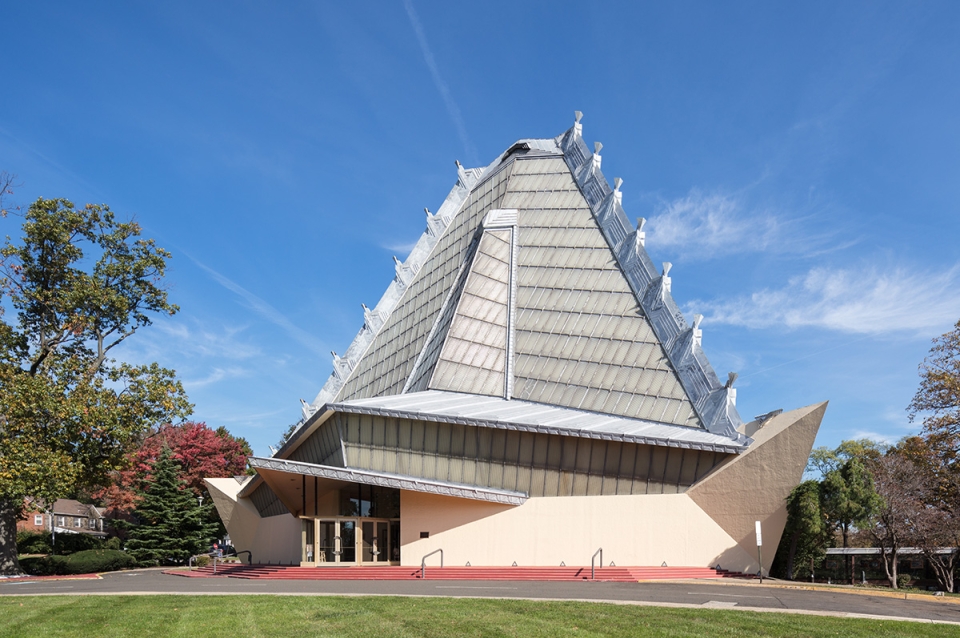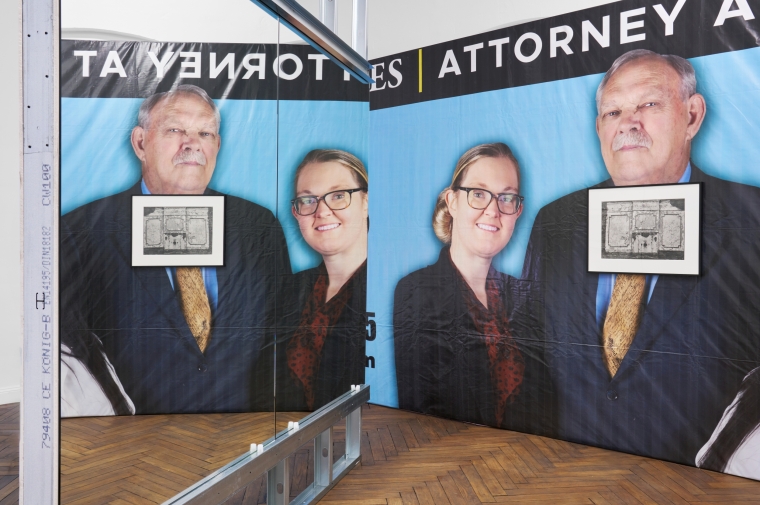April 29, 2019
Stuart Weitzman School of Design
102 Meyerson Hall
210 South 34th Street
Philadelphia, PA 19104
Get the latest Weitzman news in your Inbox
Media Contact
Michael Grant
mrgrant@design.upenn.edu
215.898.2539
When the Beth Sholom Synagogue Preservation Foundation approached David Hartt, assistant professor of fine arts, proposing that he create a site-responsive installation for the interior of the Elkins Park, Pennsylvania, synagogue designed by Frank Lloyd Wright, he was interested in the project for many reasons. The commission is one part of the Foundation’s work to both preserve the building and increase public access to this landmark structure. Hartt, who happens to live nearby the synagogue, has made several bodies of work focused on the built environment, including a 2011 series of photographs documenting the architecturally significant interiors of the Johnson Publishing Company Headquarters in Chicago, which have since been demolished.
While the most obvious path for the commission would have been creating a work that celebrated the building’s famed design and lauded architect, Hartt’s approach was much less direct. “One of the things I really struggled with at the beginning was the building. I didn’t want to make a work about the building,” he said. “I wanted to think more broadly.” He also made clear from the beginning that his work would not be a celebration of Wright or the architectural significance of the building. “I’m not interested in the cult of Wright,” says Hartt. Hartt accepted the Foundation’s invitation last summer and began working on the project, which will debut in September.
Hartt was drawn to the ways that the site and its congregation were impacted by diaspora. The current synagogue is actually the second home for the congregation; its first was on North Broad Street in Philadelphia, a building that now houses the Beloved St John Evangelistic Church, a Baptist congregation serving a community which is now predominantly African-American. The history of the Beth Sholom congregation, said Hartt, “made me think about site. And the impermanence of communities that move through different sites. And what traces are left as a result of that kind of occupation. It made me think more broadly about the constant movement of black and Jewish communities as a result of political economic and social dynamics.” Hartt sees the change of use at the original synagogue location as a kind of rewriting of history, which to him is a productive act. “That keeps the site vital. So as opposed to freezing it in time, how do we actually provoke a new reading?”
Because of the landmark status of the Synagogue, Hartt cannot make structural changes to the space, so he was compelled to use “a very light touch.” He decided to activate the space through sound. His interest in the diasporic history of the site aligned with his interest in the 19th-century American composer Louis Moreau Gottschalk. Gottschalk, who was enormously popular during his lifetime, but is mostly forgotten today, was raised in New Orleans by a father who was Jewish and a Creole mother. While receiving a classical training in Europe, he began to compose works inspired by African American and Afro-Caribbean musical traditions. For Hartt, Gottschalk was “like a Bruno Mars, an incredible composer and this incredible performer, but also totally pop. His music is charming, beautiful, and complex. For me, he became this kind of delightful cipher for helping me try to understand some of the currents of diaspora in the United States.” Gottschalk was also a slave owner, who later became active in the abolitionist movement, which “showed both a kind of intellectual and cultural evolution.”
Hartt sought out the Ethiopian pianist Girma Yifrashewa to record several Gottschalk works, which will be played in the space. Yifrashewa is also a composer whose work incorporates Ethiopian music into the classical idiom. “I see in Girma a synthetic figure and I’m trying to bridge these geographies and these cultures in a way that shows how these kinds of movements and engagements can be catalysts.”
Other elements of the project respond to the design of the building including its soaring, complex glass roof. “It leaks like a sieve,” says Hartt. “On a number of visits, I encountered kiddy pools and buckets to catch water. So how do I contend with kiddy pools and buckets? It is impossible to ignore them.” Working with local business City Planter, Hartt is designing a series of plantings using orchids and other tropical plants for the many built-in planters that Wright created for the space, which are currently filled with artificial plants. The designs are inspired in part by the work of Martin Johnson Heade, an American painter known for his portrayals of lush tropical plants and hummingbirds. Heade was part of circle of abolitionists, artists, writers, and thinkers that peripherally included Gottschalk, as well as Harriet Beecher Stowe, making him a kind of “visual analog to Gottschalk.”
The curator of the project, Cole Akers, who is also the curator at The Glass House, the former home of architect Philip Johnson, sums up Hartt’s project by saying, “David's poetic approach to the built environment reframes familiar ideas about site, history, and identity. His project reflects on the building's capacity to hold a generous, porous, and speculative concept of community.” Several other components of the project, which has been funded by the Pew Center for Arts & Heritage, are currently in development, including a series of tapestries being produced in Belgium and a series of films shot in New Orleans and Haiti. A series of performances will take place as part of the project when it opens in September.


 Expand Image
Expand Image

